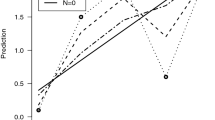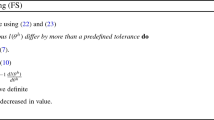Abstract
Linear mixed models have become popular in many statistical applications during recent years. However design issues for multi-response linear mixed models are rarely discussed. The main purpose of this paper is to investigate D-optimal designs for multi-response linear mixed models. We provide two equivalence theorems to characterize the optimal designs for the estimation of the fixed effects and the prediction of random effects, respectively. Two examples of the D-optimal designs for multi-response linear mixed models are given for illustration.
Similar content being viewed by others
References
Baltagi BH (1995) Econometric analysis of panel data. Wiley, New York
Christensen R (2002) Plane answers to complex questions: the theory of linear models. Springer, New York
Dahm PF, Melton BE, Fuller WA (1983) Generalized least squares estimation of a genotypic covariance matrix. Biometrics 39:587–597
Davidian M, Giltinan DM (1995) Nonlinear models for repeated measurement data. Chapman and Hall, London
Debusho LK, Haines LM (2008) \(V\)-optimal and \(D\)-optimal population designs for the simple linear regression model with a random intercept term. J Stat Plan Inference 138:1116–1130
Debusho LK, Haines LM (2011) \(D\)- and \(V\)-optimal population designs for the quadratic regression model with a random intercept term. J Stat Plan Inference 141:889–898
Diggle PJ, Heagerty P, Liang KE, Zeger SL (2002) Analysis of longitudinal data. Oxford Science, New York
Entholzner M, Benda N, Schmelter T, Schwabe R (2005) A note on designs for estimating population parameter. Listy Biom Biom Lett 42:25–41
Fedorov VV (1972) Theory of optimal experiments. Academic Press, New York
Fedorov VV, Hackl P (1997) Model-oriented design of experiments. Springer, New York
Henderson CR (1975) Best linear unbiased estimation and prediction under a selection model. Biometrics 31:423–477
Henderson CR, Kempthorne O, Searle SR, von Krosigk CM (1959) The estimation of environmental and genetic trends from records subject to culling. Biometrics 15:192–218
Kiefer J (1959) Optimum experimental designs. J R Stat Soc B 21:272–304
Jensen KL, Spiild D, Toftum J (2012) Implementation of multivariate linear mixed-effects models in the analysis of indoor climate performance experiments. Int J Biometeorol 56:129–136
Laird NM, Ware JH (1982) Random effects models for longitudinal data. Biometrics 38:963–974
Luoma A, Nummi T, Sinha BK (2007) Optimal designs in random coefficient cubic regression models. J Stat Plan Inference 137:3611–3617
Prus M, Schwabe R (2016) Optimal designs for the prediction of individual parameters in hierarchical models. J R Stat Soc B 78:175–191
Schmelter T (2007a) The optimality of single-group designs for certain mixed models. Metrika 65:183–193
Schmelter T (2007b) Consideration on group-wise identical designs for linear mixed models. J Stat Plan Inference 137:4003–4010
Schmelter T, Benda N, Schwabe R (2007) Some curiosities in optimal designs for random slopes. In: Jesus L-F, Juan MR-D, Bernard T (eds) Moda 8—advances in model-oriented design and analysis. Physica-Verlag, Heidelberg, pp 189–195
Schwabe R, Schmelter T (2008) On optimal designs in random intercept models. Tatra Mt Math Publ 39:145–153
Silvey SD (1980) Optimal design. Chapman and Hall, London
Sun Y, Sinha BK, Von Rosen D, Meng QY (2003) Nonnegative estimation of variance components in multivariate unbalanced mixed linear models with two variance components. J Stat Plan Inference 115:215–234
Verbeke G, Molenberghs G (2000) Linear mixed models for longitudinal data. Springer series in statistics. Springer, New York
Vonesh EF, Chinchilli VM (1997) Linear and nonlinear models for the analysis of repeated measurements. Marcel Dekker, New York
Wang CM, Lam CT (1997) A mixed-effects model for the analysis of circular measurements. Technometrics 39:119–126
Acknowledgements
Dr. Yue and Dr. Liu were partially supported by the National Natural Science Foundation of China under Grants 11471216 and 11871143. Dr. Wong was partially supported by a Grant from the National Institute of General Medical Sciences of the National Institutes of Health under Award Number R01GM107639. The content is solely the responsibility of the authors and does not necessarily represent the official views of the National Institutes of Health.
Author information
Authors and Affiliations
Corresponding author
Appendix
Appendix
We provide justifications for Theorems 1 and 2 using the same notation from the main text.
1.1 A.1. Proof of Theorem 1 and 2
Here we establish the proof using similar arguments in Prus and Schwabe (2016) and invoking the general equivalence theorem (Kiefer 1959).
For the D-optimal criterion \(\psi _D(\xi )\) defined in (12), a direct calculation shows that the directional derivative at \(\varvec{M}_1\) in the direction of \(\varvec{M}_2\) is
As in Silvey (1980), a standard argument based on convex analysis then establishes Theorem 1.
To determine the directional derivative for the modified D-criterion \(\psi _D^{pred}(\xi )\) we write the criterion in the form
where \(m\varvec{K}\varvec{K}^T={\varvec{\Delta }}.\) As a consequence, this criterion can be identified as a compound criterion with the directional derivative:
which proves Theorem 2. \(\square \)
Rights and permissions
About this article
Cite this article
Liu, X., Yue, RX. & Wong, W.K. D-optimal designs for multi-response linear mixed models. Metrika 82, 87–98 (2019). https://doi.org/10.1007/s00184-018-0679-7
Received:
Published:
Issue Date:
DOI: https://doi.org/10.1007/s00184-018-0679-7




